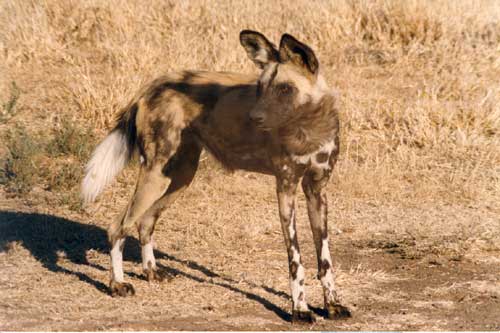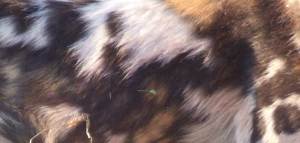 African wild dogs Lycaon pictus are considered one of Africa’s most endangered carnivores, with only an estimated 5000 remaining in the wild (1). Although historically present across most of sub-Saharan Africa, wild dogs now have viable populations in only a few remaining African countries (2, 3) and are considered endangered by the IUCN.
African wild dogs Lycaon pictus are considered one of Africa’s most endangered carnivores, with only an estimated 5000 remaining in the wild (1). Although historically present across most of sub-Saharan Africa, wild dogs now have viable populations in only a few remaining African countries (2, 3) and are considered endangered by the IUCN.
As their name suggests, wild dogs are members of the Canidae, or dog, family, although they are a separate evolutionary line to all other canid species that survive today and are, therefore, the only surviving members of ‘Lycaon’. They are not in any way feral domestic dogs (Canis lupus familiaris) but are a completely different species, and behaviourally similar to wolves (Canis lupus). Their Latin name Lycaon pictus means ‘painted wolf’, and each dog is indeed a riot of tan, black, white and yellow blotches in a pattern unique to each individual.

Wild dog coat - each is individual
Wild dogs are social carnivores, usually living in packs of 4-20 individuals (4), in which only the alpha (top-ranking) male and female breed, producing up to 21 pups yearly (5). Other pack members help raise the pups, to whom they are usually related (6, 7). Due to this need for helpers, and other important factors (discussed below), 4-6 adult dogs are usually needed to form a pack that can breed successfully (8, 9). When packs get large, a sub-group of one sex will break away (termed ‘dispersal’). When this sub-group meets another dispersing group of the opposite sex, a new pack can be formed (10).
Wild dog packs are nomadic and inhabit vast home ranges of between 250 and 2000 sq km at very low densities of 2-35 dogs/1000 sq km (6, 7). Eight packs are considered minimal for long-term viability, leaving few reserves in Africa large enough to hold sustainable wild dog populations (11). Consequently many reserve populations may have to be managed as part of a metapopulation in the future, with translocations between parks, and also captive packs, to maintain genetic diversity and avoid inbreeding and other problems of small populations (2).

Male impala - wild dog prey (by Sam)
Wild dogs are crepuscular (3), which means they are active at dawn and dusk. They hunt as a pack usually eating small-medium antelope, in particular impala (12), which they ‘course’, running after the prey until it drops from exhaustion – a hunting style also used by wolves. Wild dogs are actually extremely efficient hunters, with a significantly higher hunt success rate than both lions and leopards.
African wild dogs are threatened by diseases such as rabies and canine distemper that spread quickly through a pack due to their greeting behaviour of licking each other’s mouths, and can wipe out entire packs. In addition, because they live at such low population densities, wild dogs require vast reserves to be fully protected and to stop them ranging outside the protected area; for example Selous Game Reserve in Tanzania is 43,000 sq km [approx the size of Switzerland] but only contains around 800 wild dogs (13). Once outside the reserve the dogs can be shot and poisoned by humans who often view them as pests or as potential predators of livestock.
Why do African wild dogs live in packs?
African wild dogs are obligate co-operators – meaning they have to live in packs to survive and breed successfully. Several factors have been found to influence the difference in survival between large and small size packs. These include:
1) Hunting success – this increases as adult pack size increases due to an increased number of animals killed simultaneously, a decrease in the chase distance of the hunt (using less energy), and an increase in prey range as a large pack enables larger, previously unobtainable, prey to be brought down successfully (9, 14, 15; but see 16).
2) Kleptoparasitism – kleptoparasitism is the stealing of food by another animal. Wild dogs are considerably smaller than lions, leopards and spotted hyaenas and these larger predators will steal wild dog kills if they can – after all, it saves them the energy and effort of catching the prey themselves. Larger wild dog packs can defend their kills more successfully and reduce kleptoparasitism by other carnivores (14).
3) Higher pup survival – larger packs raise more offspring by three main methods a) being able to leave behind a ‘babysitter’ while the rest of the adults go hunting, who can protect or move vulnerable pups, b) by mobbing larger predators, forcing them to leave (other predators, such as lion, leopard and hyaena are a significant cause of pup deaths), and c) by sharing the stress of regurgitation to pups between more adult individuals (once pups are weaned, wild dogs feed them by returning to the den after a hunt and regurgitating the meat they have recently eaten for the pups to eat) (6, 9).
4) Vigilance – larger packs have more eyes and so are more vigilant, enabling them to spot other predators more quickly. This could potentially decrease lion mortality (17), which is responsible for up to 50% of adult wild dog deaths and a large proportion of pup deaths (4).
5) Territory defence – larger packs are more successful at defending their territories; for example, in Selous Game Reserve, Tanzania, 10 out of 10 pack disputes seen were won by the larger pack (4).
Further info:
IUCN Canid Specialist Group – http://www.canids.org/species/Lycaon_pictus.htm
References
1. Fanshawe JH, Frame LH & Ginsberg JR. 1991. ‘The wild dog – Africa’s vanishing carnivore.’ Oryx 25: 137-146
2. Woodroffe R & Ginsberg JR. 1997. ‘The role of captive breeding and reintroduction in wild dog conservation.’ In: African wild dog status survey and action plan (R Woodroffe, J Ginsberg & D Macdonald eds). IUCN/SSC Canid Specialist Group, IUCN Gland, Switzerland. Chapter 7
3. Creel S & Creel NM. 1998. ‘Six ecological factors that may limit African wild dogs Lycaon pictus.’ Animal Conservation 1: 1-9
4. Creel S & Creel NM. 1996. ‘Limitation of African wild dogs by competition with larger carnivores.’ Conservation Biology 10: 526-538
5. Smithers RHN. 1992. ‘Land mammals of southern Africa – a field guide.’ 2nd Ed. University of Pretoria, South Africa p110
6. Malcolm JR & Marten K. 1982. ‘Natural selection and the communal rearing of pups in African wild dogs (Lycaon pictus).’ Behavioral Ecology and Sociobiology 10: 1-13
7. Girman DJ, Mills MGL, Geffen E & Wayne RK. ‘A molecular genetic analysis of social structure, dispersal, and interpack relationships of the African wild dog (Lycaon pictus).’ Behavioural Ecology and Sociobiology 40: 197-198
8. Estes RD & Goddard J. 1967. ‘Prey selection and hunting behavior of the African wild dog.’ Journal of Wildlife Management 31: 52-70
9. Creel S & Creel NM. 2002. ‘The African wild dog: behavior, ecology and conservation.’ Princeton University Press, New Jersey
10. McNutt JW. 1996. ‘Sex-biased dispersal in African wild dogs Lycaon pictus.’ Animal Behaviour 52: 1067-1077
11. Hofmeyr M. 2001. ‘Introduction of the African wild dog (Lycaon pictus) to game reserves.’ Proceedings of a symposium on the re-introduction of larger mammals to game reserves October 2001. Onderstepoort, South Africa
12. Owen-Smith N & Mills MGL. 2008. ‘Predator-prey size relationships in an African large-mammal food web.’ Journal of Animal Ecology 77:173-183
13. IUCN Canid Specialist Group: http://www.canids.org/species/Lycaon_pictus.htm. Accessed Sept 2010.
14. Fanshawe JH & Fitzgibbon DC. 1993. ‘Factors influencing the hunting success of an African wild dog pack.’ Animal Behaviour 45: 479-490
15. Creel S & Creel NM. 1995. ‘Communal hunting and pack size in African wild dogs, Lycaon pictus.’ Animal Behaviour 50: 1325-1339
16. Carbone C, Du Toit JT & Gordon IJ. 1997. ‘Feeding success in African wild dogs: does kleptoparasitism by spotted hyaenas influence hunting group size?’ Journal of Animal Ecology 66: 318-326
17. McNutt JW. 1996. ‘Adoption in African wild dogs, Lycaon pictus.’ Journal of Zoology, London 240: 163-173
Information correct at 23.09.2010
Read Full Post »
 African wild dogs Lycaon pictus are considered one of Africa’s most endangered carnivores, with only an estimated 5000 remaining in the wild (1). Although historically present across most of sub-Saharan Africa, wild dogs now have viable populations in only a few remaining African countries (2, 3) and are considered endangered by the IUCN.
African wild dogs Lycaon pictus are considered one of Africa’s most endangered carnivores, with only an estimated 5000 remaining in the wild (1). Although historically present across most of sub-Saharan Africa, wild dogs now have viable populations in only a few remaining African countries (2, 3) and are considered endangered by the IUCN.

